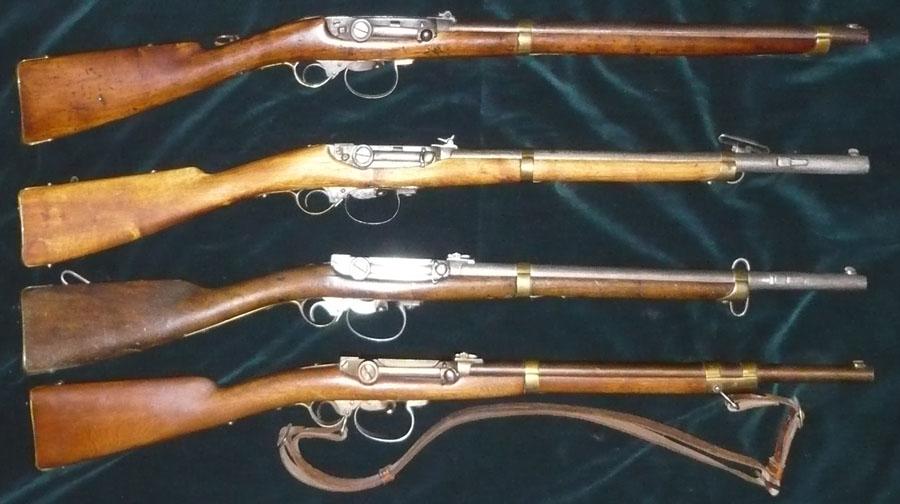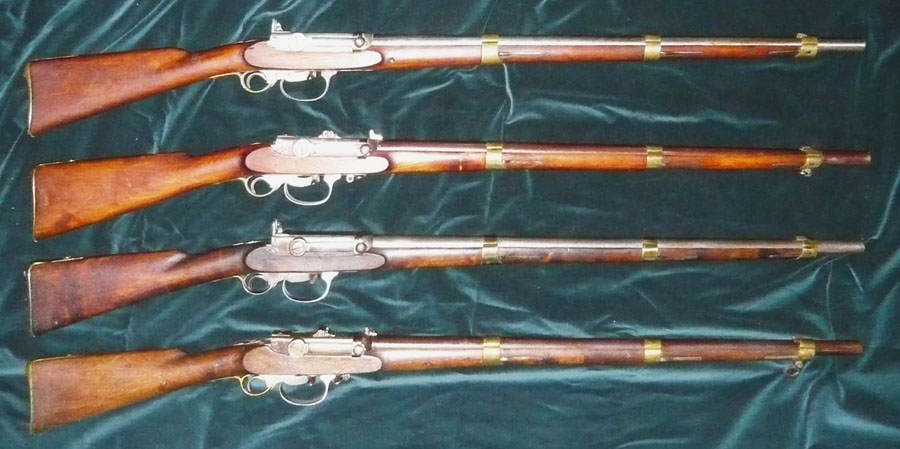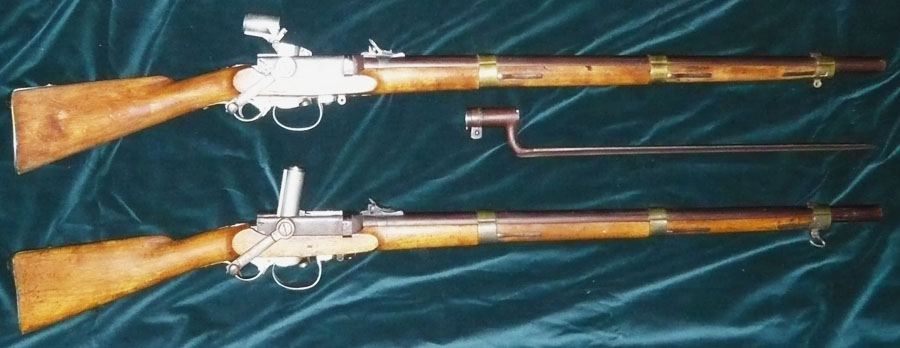The kammerlader rifles
This is an article I wrote in the late 1990s. Just about all the information here is to be or will be found under the various models, but there the information is more detailed. I will, however, keep the article and update it as it probable will give a better understanding of the most Norwegian long-gun of them all. Pictures will be added to the last part of the article.
Norway started an arms-race on small-arms in the 1830’s. A lot of “modern” long-guns were tried out. Some, like the Malmberg and the Enger, were produced in limited series for testing, but the dream was to have a breech-loader. Breech-loaders are a lot faster reloading than muzzle loaders. Perhaps at least equally important, loading a chamber enables better contact between bullet and the rifled barrel. This results in higher air-speed, better rotation and much better accuracy.
Løbnitz had made a passable breech-loader in Denmark in the mid 1830’s, but Norway was trying for something more than passable. The picture shows one over the very first attempts Kongsberg made. The hammer is placed as on the early Løbnitz, but the crank and chamber are very close to what became production models. (I actually found this one in England, wonder how it landed there.)
The first Norwegian military breech loaders (1842-1870)
This illustrated article covers the main models of of the most “Norwegian military rifle” to be found – the Norwegian kammerladnings gevær.
Fergurson and Hall came out with their flintlock breech loaders decades before 1842, but Norway was probably the first country in the World to introduce breech loaders full scale in the army and in the navy. There seems to have been made a total of some 40 000 kammerladere (chamber loaders) in the years from 1842 to 1870, spread over more than 80 version and variations.
The army models
M1842 – t here were only ordered 500 of these in total – all for the army, 100 produced at Liege and 400 at Kongsberg. The M1842 is easely identified by the very narrow grip with a ridge on the hammer.
here were only ordered 500 of these in total – all for the army, 100 produced at Liege and 400 at Kongsberg. The M1842 is easely identified by the very narrow grip with a ridge on the hammer.
Allthough 500 rifles were ordered, it seems probable that only some 300 of them ever were produced as the army’s M1842. I have a hunch that about 200 of these rifles first were completed and assembled in the mid and late 1840′s, but as a shortened version for the navy.
There is no logic in producing an outdated model for the navy years after revised army models had been put in to production. The highest serial number I’ve found so far on an early navy kammerlader with the M1840 hammer is # 99, but there were two series of these – the navy M1845 and M1849.
Next army model out was the M1846 with some minor alterations to the mechanism and a wider hammer grip. Appr. 3000 of the M1846 was made at Kongsberg, numbered 1-3000. 1500 were made at A. Francotte in Liege and another 1500 at Crause in Hertzberg – all three series with serial numbers starting from 1! Both the M1842 and the M1846 originally had the same rear sight as shown on the right.
M1842 and M1846 with M1855 rear sight are easely identified as they have two screws holding the square plate behind the breech chamber in place. Narrow hammer with a ridge, it is a M1842. Wider hammer with a flat handle, it is a M1846.
M1849 is again slightly modified in the mechanism with ao an even wider hammer and got a new rear sight, this also placed behind the breech block. The stock was curved from the trigger guard to the but. Kongsberg made some 6500 of this one, Liege and Hertzberg 2000 each – and again all three producers started their serial numbers from 1.
On M1849′s converted to the new rear sight, there is tapped in a little steel plate on the left hand side of the square plate behind the breech chamber. The workmanship is very good and the easiest way of seeing this is often that the serial number is slightly on the right hand side of the plate.
A “new” M1855 was made with the rear sights moved and fixed with a ring to the barrel. Kongsberg made some 4000 of these, numbers being added on the numbers from M1849. The old M1842, M1846 and M1849 also had their rear sights changed according to this and an army version of the Kammerlader with the original rear sight from before 1855 is extremely difficult (virtually impossible) to find.

The M1849/55 kammerlader is one of the three most common kammerladere to be found for collectors
In 1859 there was a new and shorter version with only two brass bands holding the barrel – following on the M1855 number series. There were made less than 1300 of this, but it still is the most common of all the Kammerladere as very many the M1855-versions were shortened down some 16 cm as well – called the M1855/59. The spring holding the first barrel band was turned 180 degrees on the converted ones and a new piece of wood was fitted in where the spring had been. The M1859 got a sword bayonet.

In 1860 Kongsberg started making a long kammerlader with socket bayonet again – the M1860 lang is almost identical to the M1855, but lighter with a 11,77 mm calibre. There were made close to 9 000 of this model.

There was also a shorter version of this, the M1860 kort is simular the M1859, for a sword bayonet. There were produced some 3000 of this model. The bayonet is virtually the same as for the Norwegian Remington, and will fit the Remington, but usually not the other way round. The short M1860 as it is a lot harder to find than its “big brother”, and a lot harder than one would believe as the production ran still was fairly high for being a Norwegian military rifle.
The cartridge converted long M1860/67 is the third of the most common kammerladere to be found.
Kammerlader carbines
There were also made several models of kammerlader percussion carbines – from the top: the M1857 (12,5 mm), the M157/59 (12,5 mm), the M1862, and a M1865 cavalry version of the M1862 without bayonet. After 1868 the carbines (M1869 cavalry & M1869 artilley) were produced for use of cartridge with Lunds design. The two first mentioned were never converted to Lund’s cartridge due to having a different caliber. The M1857 is very scarce and the M1857/59 even more so (the one on the pictures has been burnt and reassembled with a new stock and new mountings).
In the early 1850’s there came a slightly different model. It ha a lot in common with the M1849, but the hammer is the same as the army’s M1849 and it had a new, original rear sight (not a conversion from the old) – skibakke sikte (the skiing hill sight).
Navy – original model M1845 & M1849
The Norwegian navy did their own things – most often differently from the army. All the naval archives were burnt as allied planes bombed the German-occupied naval base in Horten during WW2, so there is really next to no literature and information on naval fire-arms.
There were 5-6 original kammerlader models used by the navy (the M1855 and the M1857 are often regarded as the same model). Most of these were rebuilt for cartridge, most according to Landmarks design, a few according to Lund and even some completely rebuilt as Remington Rolling Blocks. To complicate things, some were fitted for cleaning rods, many not. Most got new rear sights, some not etc. As a result, there are about 25 different variations of the naval kammerladers. The following will concentrate on the main models an rebuilds.
The picture shows the naval M1845 (at the bottom) and the M1849
The first naval model, the M1845, is a three band version almost identical to the army’s M1842, except that it has about the same length as the short army M1859. As with the army’s M1842, the brass bands proved to be too thin etc. and a new, visually almost identical, model was released in 1849. There were only made 100 of the M845. The quantity of “the true” M1849 is unknown, but it seems they were made in batches numbered up to 100. There was also produced a number of naval kammerladers in 1850-51, almost identical with the M1849, but with the wider hammer from the army’s M1846. These are not regarded as a new model and I have seen numbers up to #136.
From the bottom: M1845/67, M1845, M1849/67 & M1849
M1852 Navy
The M1852 naval kammerlader is one of the most attractive ones of all the kammerladers. It’s weird skibakke (ski-jump) rear sight is just the dot over the eye. Just about all the naval kammerladers were converted to cartridge, but every once and again an original pops up.
As far as I can remember, I’ve never seen this rifle dated earlier than 1854, but it is regarded as aM1852 model. Some of these have had the rear sight changed in 1867 and can then be difficult to hold apart from the M1848. The latter has two screw on the plate on the rear of the receiver. These are missing on the M1852 and later models. The highest serialnumber I have seen is 552, but I believe the were made some 600 of this rifle.
Sorry about the glare in the picture – shit camera! New one on its way.
The same two rifles, the lower an original kammerlader, the other rebuilt for cartridge.
Naval M1855 & M1857
In 1855 there came a new two-band naval kammerlader with a more primitive rear sight (but probably more practical). The “old” M1845 and M1849 were also fitted with this rear sight. Even some of the M1852 lost their ski-jump sight to the new one.
The M1855/67 at the bottom, M1857/67 and M1857/67 Lund’s conversion.
Already in 1857 there came a modified version of the M1855, now with a heel on the but-plate. This M1857 is recognized as a separate model amongst Norwegian collectors, I’m not sure I agree to this.
 The picture shows the different versions of the 18 lødig (16,8 mm bore) kammerlader. From the left, the original “muzzle loaded” breech chamber, the Landmark cartridge system where the chamber folds over and one actually loads it backwards and an experimental Lund’s cartridge conversion til the right. The Landmark was a much smarter conversion than the Lund. Less work modifying, faster loading and it still could be used with the paper cartridges by putting the old chamber back in. So why then did the army chose Lund?
The picture shows the different versions of the 18 lødig (16,8 mm bore) kammerlader. From the left, the original “muzzle loaded” breech chamber, the Landmark cartridge system where the chamber folds over and one actually loads it backwards and an experimental Lund’s cartridge conversion til the right. The Landmark was a much smarter conversion than the Lund. Less work modifying, faster loading and it still could be used with the paper cartridges by putting the old chamber back in. So why then did the army chose Lund?
Naval M1860
The Navy M1860 is almost identical to the short two band version of army’s M1860, with three minor exceptions. The navy seemingly just had to be different, so they adopted the three edged bayonet from the long army M1860 instead of the sword bayonet from the short one. The two other differences are that the rear sight is rather primitive compared to the army’s version and that the modification on the breech handle from the M1845 is partly still there. Why to something simple, when you can do it navy!
The rifle on the picture (sorry about the quality) was used by Sjøkrigsskolen (The Sea War School) and was fitted with a sword bayonet. The navy then decided that all the naval kammerladers shold be fitted with socket bayonets and this has been through a very rough bayonet conversion. The rifle is actually brand new, not even restained after the conversion.
Army cartridge conversion
The army settled for a Lunds design in converting the kammerladere from percussion to metal cartridge in 1867. There were made a very limited series, probably from leftovers, as 16,8 mm Lunds rifles in 1867/68. These are, as far as I know, the only 16,8 mm Lunds ever made and none of the excisting army percussion versions seem ever to have been converted. Si picture above.
Both the long and the short M1860 were converted according to Lunds patent and there are extremely few military M1860’s left in percussion. With the exception of the M1857 kammerlader carbine, just about all the carbines were also converted to Lund.
Although much cheaper than producing a new rifle from scratch, the Lund conversion was rather comprehensive. The brass bottom plate was exchanged for a steen plate with a milled track for the extractor. The whole chamber piece was exchanged and the right side of the outer chamber was milled down – see picture.
At first glance, the Lund conversion seems to be a really good solution for firing the Remington cartridge in the M1860, but I’m not sure it was all that great. It was a slow loader and leaky cases would give the extractor problems.
Navy cartridge conversion
It seems as if the navy yet again had to do things their own way and they settled for the Landmark design for converting the kammerladere to cartridge guns. While the army only converted their M1860’s, the navy seemed to have converted all their kammerladere –
the M1852 and M1860kammerladere – even most of their M1845.
The Landmark conversion was fairly inexpensive, but seems at first glance rather fragile and very backward in use. In reality I believe this to be the better conversion of the two. It enables faster loading, there would never be problems with the extractor and is just as rugged as the Lund. This time it seemed to be the navy pulling the longest straw.
The Lund conversion to cartridge was mainly used on the 4”’ kammerlader – the 1860 models. Although the caliber was 11,77 mm, it used the 12,17 mm Remington rim-fire cartridge.
The pictures shows the 16,8 mm kammerlader converted for cartridge. This is one short and fat little cartridge!
Back to main page
Mail me with more info or trade
Civilian Kongsberg versions of the kammerlader
The M1860 kammerlader was also made in two civilian version – the long and the short (here the long three band version is fairly scarce and the short two band rather common). The M1860 is equipped with steel bands and not the brass bands from the military versions and are thereby very easy to identify.
Whilst almost all the M1860 military versions were rebuilt for either the Lund or Landmark cartridge, most of the civilian rifles still exist with the open chamber. Be aware that it is almost impossible to detect if a Landmark has been converted back to a open M1860 and that there exist a number of “fakes” of this version.
The civilian M1860 was mainly produced for the “Frivillige skyttervesen” – that also was intended to act as a paramilitary organization in case of trouble with the enemy (read: The Swedes).
The different versions of the M1860 mechanism
The original version of the M1860’s was a percussion breech loader for paper cartridge. The breech chamber was withdrawn and raised by cranking the handle. The rifle bottom rifle on the two pictures show the original breech chamber.
The rifle in the middle is the army’s Lund conversion, where the whole chamber piece was exchanged and the brass plate under the chamber exchanged for a steel plate with a track for the extractor.
The rifle on the top in the navy’s Landmark, where only the front of the chamber was exchanged. This conversion was less costly than the Lund conversion.
In addition to these, a few M1860’s were fitted with a Remington mechanism for the navy and I’ve even had a very scarce army version with a falling block cartridge versions of the M1860
Other civilian kammerlader’s
There was also produced a limited number of kammerlader’s by gunsmiths in Norway, Larsen’s various models are probably the best known. They are rather scarce, in fact I’ve only seen a total of three or four of them.
Compared to the military kammerlader’s, my Larsen has a fairly small and short arm for kranking up the chamber.
The other picture shows a Larsen “relic” that was for sale in the US (no, I did not buy it – frightfully expensive and in terrible condition). This has a round barrel and a much longer arm.
Evidently the civilian kammerlader’s came in “all shapes and forms and started coming already in the early 1840’s.
I’m really fascinated with the Norwegian kammerlader’s, probably the most “Norwegian” weapon of all. Both Sweden and Denmark had their versions, but their kammerlader’s had nothing close to the success the Norwegian ones had.








